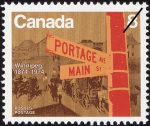I was born here in 1924. The city then carried the red badge of the 1919 General Strike “when the state trembled,” in the words of historians Reinhold Kramer and Tom Mitchell. Winnipeg to this day remains politically very much left of centre. Since 1969 the city has elected a majority of the NDP caucus in the legislature, sufficient to make it the governing party of Manitoba for 33 of 43 years.
I belonged to the Young Pioneers from age five. We were provided with red kerchiefs and blue forage caps, which we proudly wore in May Day parades. My boyhood home on Lansdowne Avenue was Winnipeg North party headquarters in the 1935 election. There was a huge banner across the front of our house, ‘Vote Communist, Vote Tim Buck.’ This being the height of tomato season, the banner got its share of missiles – as did our neighbour’s porch, when the tomatoes misfired.
That’s Winnipeg.
My father Jacob was one of the founders of the Communist Party of Canada. He served 25 years on City Council. When he was released from wartime internment in 1942 simply for belonging to a banned organization, he was greeted at the CPR station by a crowd of 5,000 well-wishers – including every member of City Council, some of whom voted to expel him at the time of his arrest.
My city is geographically, culturally, sociologically, politically, the heart of the continent. It is uniquely a “prairie metropolis,” as historians Gerald Friesen and Ed Rae put it. Home still, as it has been for all its 140-year history, to immigrants and refugees from every continent, Winnipeg is a friendly, tolerant place, though all too much racism and discrimination still exists.
There is an ethnic and cultural richness in the folk festivals, Royal Winnipeg Ballet, symphony and theatre companies.
Novelist Margaret Laurence spent five years in Winnipeg. In 1948 she wrote a long poetic essay about the city North Main Car, following the streetcar as stop by stop it picked up workers wending their way to downtown shops and factories. The work was never published in her lifetime but discovered in an archive at York University after her death (Winnipeg Connection 2006, editor Birk Sproxton). The last stanza says a great deal of what lies strong in the class culture of Winnipeg, the heart of the continent:
Oh all of us have been separated long enough
By the cruel-crushing wall of race and creed
Looming between us. Let us take these old grey
outworn blocks
heave them apart, turn them around to the sun,
and see revealed the richness of our diversity,
the colors of speech and songs splendor.
Let us build of the sea new structure, a fortress
Founded on common creed, our bond as
Workingmen:
A base against oppression, our first bastion of
Tomorrow.”
(Editor’s note: the author was a former attorney general of Manitoba and WWII combat veteran of the Normandy campaign. Mr. Penner’s commentary was originally published March 9, 2014. He died in 2018 at 93)






